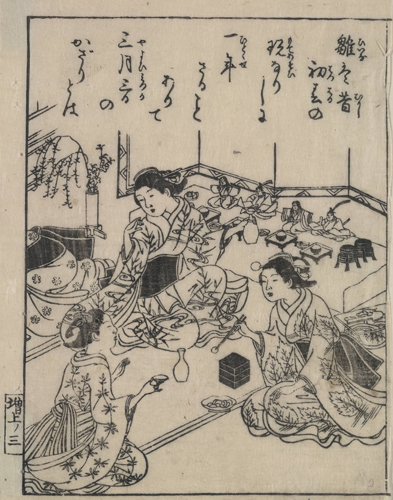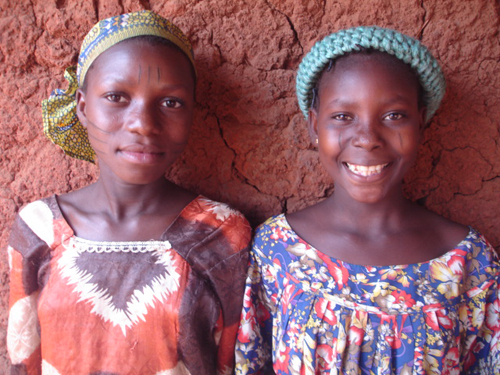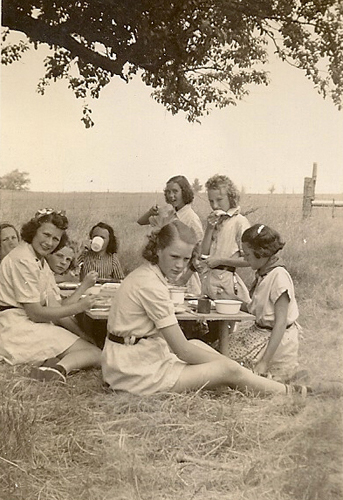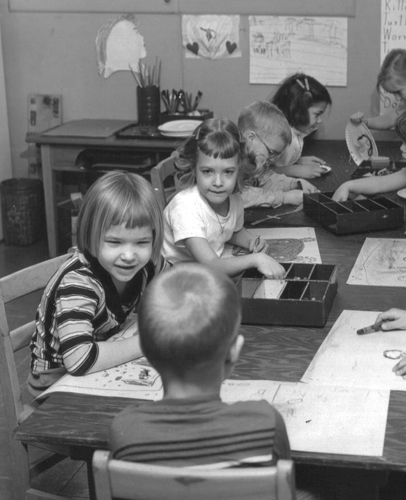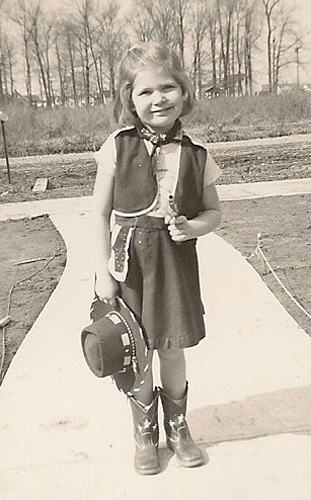 This is Girl Museum’s first exhibition to showcase what we are about, our point of view and what topics we will explore further in the future via our four exhibition streams: Girlhood in Art, Art of Girlhood, Girls in the World, and GirlSpeak.
This is Girl Museum’s first exhibition to showcase what we are about, our point of view and what topics we will explore further in the future via our four exhibition streams: Girlhood in Art, Art of Girlhood, Girls in the World, and GirlSpeak.
Throughout the vast history of art, children often were not depicted, and girls even less so. Yet they can be found in painting, sculpture, photography and drawing in most cultures, most prolifically after the mid 19th century. Before the Renaissance, most likely they were represented only in death.
Girls who were not of a wealthy, titled background were also unlikely to have their likeness recorded. This absence of representation makes understanding what girl’s lives were like even more difficult.
From the marginalized place of the girl, our exhibitions are sites to examine the images that do exist and how these representations coalesce on the body and mind of the girl, young and old. Whether a specific personality, a body of projected neuroses, an allegory, a symbol or an esoteric ideal, we acknowledge her presence as both necessary and important.

Girl, defined:
‘Girl/gurl/gyrle’ was originally used to describe a child of either sex and did not specifically refer to females until roughly the 16th century. Although obscure, the root connotation of ‘girl’ is common in most languages, meaning unmarried or sexually inexperienced female as well as servant or slave. Since childhood itself was only acknowledged in the mid 19th century, the cultural meanings inscribed are more historically ingrained than the word used to describe them. For us, ‘girl’ is not defined as property, victim or the opposite of ’boy’. It is both our subject and point of reference.
What art history gives us primarily is a record of the sanctioned behaviors of girls by individual artists (mostly men), families, communities, religious organizations and governments. Today, they are produced by advertising and media companies acting on behalf of maximum profit rather than ethical accountability. The girls’ points of view are not likely a consideration as their physical and financial security is firmly out of their control. Let’s take time to look and try to understand,remember and respect their role in human history.

Museum, defined:
Our goals include building an archive dedicated to preserving and learning about girlhood. As we gather information about girls and girlhood, we hope to be encyclopaedic when possible, to include all manner of material culture. In this way, we are crossing over categories and integrating learning about the subject of girlhood as both the parts and sum.
This new museum model of practically no overhead is an experiment. Like a new garden, we are seeing what we are able to grow on the web- an archive and a point of reference to look at art and social history in a different way. Girl Museum is also a virtual venue for our global community to celebrate and explore the importance of girlhood of the past, present and future through collaborative and interactive exhibitions and projects.
Girlhood in Art, defined:
Representations of children in art demonstrate changes in cultural values throughout history. The wealth, values and social status of the family are as important as the worthiness of children themselves to be recorded. However, these images often reveal the underlying attitudes towards children, particularly girls.
In order to understand the ways girls are shown in art, some distinctive themes emerge: Daughter, Mother, Warrior, Princess, Servant, Temptress, and Child. While there are many variations within each category, they serve as ways to frame the view.
Often girls are shown unclothed in art and the meanings of this vary according to time and context. Innocence was often represented by a nude girl, however, the older the girl, the less innocent her body. These ideas were not from the girls themselves, but the male dominated societies that produced the images. These and other visual contradictions are everywhere for society’s consumption, whether or not they approve.
The struggle between social expectations and behavior is the root of much human anxiety and this is revealed through its art. The following artworks are exemplary of the various categories of ‘girl’ that will be explored in much further depth in future ‘Girlhood in Art’ exhibitions.

House altar depicting Akhenaten, Nefertiti and three of their Daughters. New Kingdom, Amarna period, 18th dynasty (1550-1292 BCE). Ägyptisches Museum, Berlin. Photo: Keith Schengili-Roberts. WikiCommons.
Throughout history, daughters were a conundrum for the family. While they may have been loved, girls usually did not bring in fortune and had the most potential to bring shame, through no fault of their own.
The earliest representations of girls in art were as members of royal family portraits. Typically full of objects that described the family’s wealth, these portraits display both their family and their own social status. This was important in Ancient Egypt as it had many female rulers and co-rulers. Egyptian art and portraiture is highly stylized and conventional, with the exception of the Amarna period of the 18th Dynasty.
Unique in history for its avant-garde religious philosophy of monotheism, the visual representation of the royal family broke with previous artistic conventions. Instead of perfected profiles and physiques, the Pharaoh Akhenaten was shown with a prominent belly and hips.
This altar shows Akhenaten and Queen Nefertiti holding their princess daughters in a scene unlike any previously recorded. This familial affection and attention reveals an unparalleled kindness and closeness that, while common for this renegade family, is not depicted again for a thousand years.
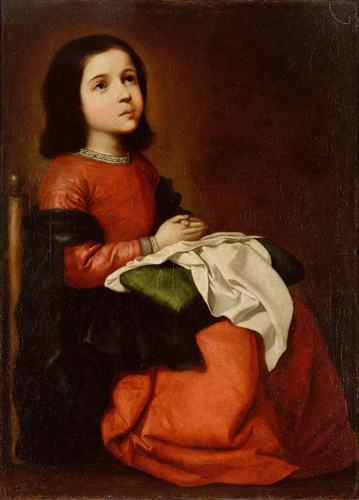
Francisco de Zurbaran, Childhood of the Virgin, c1658 – 1660, Hermitage, St.Petersburg. WikiCommons.
Thought of as small adults for much of history, children were often relied upon to take on more mature aspects of life. Girls, as mothers in training, are often depicted taking care of their dolls or siblings. These nurturing roles are both descriptive and proscriptive of girlhood behaviors.
With the Catholic Church being one of the most prolific patrons of Western art, scenes of caretaking girls are commonly found in spiritual or religious contexts. The most important girl in Christianity was Mary, the future mother of Jesus. Discussed in 2nd century CE texts, her girlhood is said to have been primarily confined within the temple from the age of three until she was married to Joseph. Such a childhood was necessary to maintain the perfection and unspoiled nature of her physical and spiritual being.
This image by Zurbarán shows Mary as a beautiful, pious and chaste girl, with her divinity illustrated as a slight glow about her head rather than a more overt halo. Mary is represented across cultures to resemble themselves, so her appearance is more a mirror than a likeness.
Girls depicted as hunters and warriors were prevalent in mythological art. However, girls as sacrifices and martyrs were more commonly found in Christian art. Perhaps the most famous girl warrior, Jeanne d’ Arc (Joan of Arc) is celebrated for her courage of convictions, her strong faith and bravery in battle. Joan’s childhood was typical of a French peasant, pious and hard working in the fields and at home.
When she was twelve years old, she began hearing voices of Saints speaking to her, and she believed they were delivering messages from God. Saint Michael the Archangel, Saint Catherine and Saint Margaret said to cut off her hair, dress in men’s clothes and take up arms to free her country from the English and restore the French throne. After successfully leading several military campaigns, Joan was abandoned by her friends and comrades. She was imprisoned and interrogated for a year.
Finally, at only nineteen years old, she was convicted of heresy and burned at the stake in 1431. While her conviction was overturned 25 years later, she was not sainted by the Catholic Church until 1920. While her true likeness is unknown, this gilded miniature, created sometime in the few decades after her death, shows Joan as a warrior woman dedicated to her cause rather than as a girl victim of politics.

Diego Velazquez, Infanta Margarita Teresa in a Blue Dress, 1659. Kunsthistorisches Museum, Vienna. WikiCommons.
Princesses and aristocratic girls had their portraits recorded often, either on their own or in groups with their families. A princess is meant to look like a doll, perfectly and meticulously maintained by a coterie of servants and attendants. She is not meant to be independent, but completely reliant on others to create her reality.
Diego Velázquez was the court painter for Philip IV of Spain, painting the Infanta Margarita Theresa many times in her young life. In this portrait, the eight year old is stunningly attired with the finest fabrics, jewels and accessories, as princesses display the wealth of the King and her potential worth.
Margarita Theresa appears rigid and doll-like in this dress, which was hopefully only for the portrait. In fact she may not have even been there for the portrait to be painted, as Velázquez would have been very familiar with her. This heavy dress would be quite restrictive, preventing her from doing anything but behave properly.
Sitting, running or even walking quickly would have been impossible. In this manner, as is often the case, fashion dictates behavior for both girls and women.

Joshua Reynolds, George Clive and his Family with an Indian Maid, 1765. Staatliche Museen, Berlin. WikiCommons.
Most children were used as domestic labor in their own homes, and many were also sent to work for others as indentured servants or slaves. European colonization created a new class of servant girls who were taken from subjugated populations, often traveling great distances, permanently separated from their families with little to no protection.
Wives brought to remote and unfamiliar environments relied heavily on the locals to make their new lives easier. These girls held unique positions within the colonial family as they would be essentially in charge of the households and children.
In this group portrait, Lord George Clive is shown with his family. Clive led many successful military campaigns for the British conquest of India, becoming the first Governor of Bengal and making an enormous fortune. His wife, Sidney, and daughter, Louisa, are named, but not the young Indian ayah (nanny) who supports the little girl in her luxurious courtly attire.
While Clive gazes at his wife, the two English women direct their attention squarely at Reynolds and the viewer. However, the Indian girl averts her eyes, casting them downwards indicating that she is both present and absent in the composition, as a function of the family, but not a part of it.
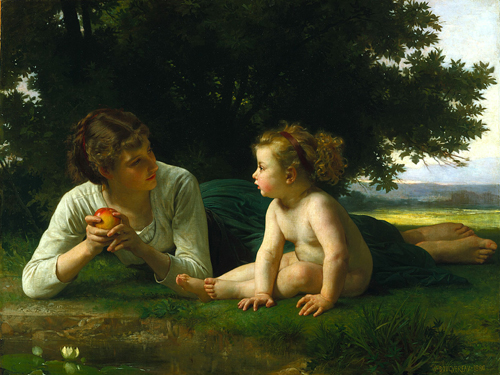
William-Adolphe Bougereau, Temptation, 1880. Minneapolis Institute of Arts, Minneapolis. WikiCommons.
Girls were often used in art to communicate social virtues and ideals through mythological or allegorical stories. In this idyllic natural setting, these two peasant girls, indicated by the older girl’s clothing, are enjoying the tranquility of a beautiful summer day. The toddler’s rosy cheeks and baby fat are endearing cherub qualities.
Additionally, being shown without clothing typically indicated the notion of innocence and a return to nature. A typical French academic salon painter, Bouguereau made many portraits of girls and was well known for his naturalistic style.
However, the intense visual engagement between the two girls communicates an unspoken lesson that is perhaps indicated by the title, Temptation. It is unclear if they are sisters or mother and child, yet the title provides the clue that this painting is not about their relationship, but an allegory.
The focus is the delicately held apple, referring to the story of Eve and the Garden of Eden. Thus the apple becomes more than just food the little girl desires to eat, but communicates her responsibility in the fall of mankind from grace and perfection. The delicate beauty of their faces also reinforces the notion that women use their aesthetic charms to tempt men.

Mary Cassatt, Young Girl in Blue Armchair, 1889. National Gallery of Art, Washington D.C. WikiCommons.
In the late 19th century, there is a marked increase in the occurrences of girls in art works. This coincided with the developing concept of childhood itself as a unique and important time. The Victorian Era developed a sort of cult of childhood. They were a popular subject of artists, especially the Impressionists. They were dressed up as little dolls at home and outdoors. While the individual character of girls was not yet important, paintings of the ballet, picnicking and swimming at the beach show a wider range of social activities in which girls participated.
Mary Cassatt was well known for painting young children more naturalistically, especially girls in cozy domestic settings. The body language of the girl in this image clearly denotes a less formal manner and truer capturing of a young girl’s behavior, her likely boredom and annoyed smirk.
Art of Girlhood, defined:
What is girlhood? Everything, really.
The elements, both concrete and intangible, that comprise girlhood have all to do with resources, choice and the varying levels of power girls have over their daily lives. It may seem obvious, yet how girls eat, sleep, dress, communicate, and move about dictates the women that they will become.
Domestic interior spaces are commonly held to be the safest setting for girlhood to take place, learning from mothers the social and familial expectations of what it means to be a girl. This may be pleasant and joyful, as well as painful and awkward.
Family size also has a large impact on girlhood, whether food, clothes and chores are shared or solo work. Whether girls have siblings to take care of, play with, dress up or hide from affects their socialization. Girls play an important part in family events, like weddings and birthdays. As well, their participation in traditional community rituals is essential for unity.
The songs, games and stories told are also important parts of girlhood to preserve. Fine art as well as diaries, photographs and material, such as jewelry, toys and clothes provides the historical evidence for us to glean girl culture. The ‘Art of Girlhood’ explores these and similar themes.
Children’s celebrations are normally confined to birthdays and puberty rites. Girls may have some sort of presentation ceremony to her community that includes a dance, like an American South debutante ball or the Bambuti Pygmies of Zaire’s ritual elima.
The United Nations has declared several worldwide days to celebrate girls and women, yet these supra-cultural holidays are not universally acknowledged or honored. For over 1000 years, the Hina matsuri, or Girl’s Day has been celebrated in Japan.
Originally coming from China, this is the oldest continually practiced celebration of girls that, although contemporized, is still observed today. It is also known as the Peach Festival, due to its springtime celebration, and Doll’s Festival because one of the most important aspects is the hina or dolls. These are usually given to a young girl by her grandparent and, are put on display in the home.
Beginning in the Edo Period, the dolls were put on display on the third day of the third month on the traditional Japanese calendar, now celebrated on March 3. The family focuses on the success of their girls, eats specific sweets and visits shrines to pray for their girls’ happiness, health, to be auspiciously married and fruitful.
The dolls become a distraction for any evil spirits that might harm the girl. Then for wealthier families, the hina could may be taken to a specific shrine to be blessed. Several shrines in Japan are popular for this festival, typically near water so that the dolls can then be floated out to sea thus ridding the land of the encapsulated negative energies. In this wood block by Sukenobu from 1749, three well dressed girls enjoy their sweet treats as the dolls can be seen set up in the background.

Unidentified young Maori woman, c 1900, unknown photographer. Reference #: PAColl-6407-14. National Library of New Zealand, Wellington.
Songs and games are a huge part of girlhood traditions. Some are learned for entertainment, while others teach social and practical skills. Whether played alone or with others, the physicality, be it dance or just movement, often combined with song, provides ways to practice coordination, memorization and group participation. Many games learned as children have their origins in training for various aspects of war, such as hopscotch, chess and even kites.
In New Zealand, Maori children are taught many different games that are derived from combat training. Today girls most often perform the poi, which are flax balls attached to flax strings swung together usually with songs. This action song helped with wrist flexibility, strength and dexterity. Combined with larger group performances, called kapa haka, many girls swing the poi in unison to demonstrate their abilities, reinforce social cohesion and honor the traditions of their culture.
The Maori girl in this portrait photograph is dressed in a traditional flax skirt. She displays the poi over her shoulder. While she probably performs with the poi, she was most likely hired by a photographer as a model to represent a ‘typical’ Maori girl for ethnographic postcards that would be sold worldwide. During the late 19th and early 20th century, this practice was common. Although it may be questionable today, these postcards do provide some evidence of objects and clothing, despite their lack of cultural context.
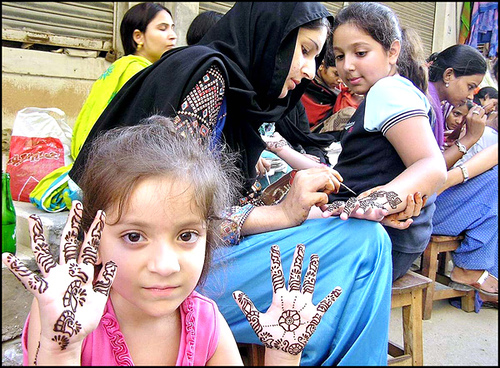
Mehndi decoration to celebrate the Eid ul Fitr in Karachi, Pakistan on October 24, 2006. Photo: Syed Abbas Mehdi. APP.
Body decoration in various forms is found all over the world. The ability to recreate or embellish physical appearance is highly valued as a means to express one’s culture and individuality. There is a wide range of methods for temporary decoration that use colorful paints, dyes and stains.
This type of adornment is used for aesthetic and customary reasons as a part of many celebrations. In the Middle East, the henna plant has been used for thousands of years to decorate the body through an impermanent skin stain. These transient tattoos are part of many Hindu and Muslim ceremonies, like birthdays and weddings.
The lengthy process involves drying the plant, crushing it into a powder, creating a paste, and then applying the meticulous designs. Waiting for them to dry is a part of the ritual that provide time for women and girls to socialize. Achieving the desired tattoo can take thirty minutes or more for an intricate application of henna paste to dry.
Especially for festivals, such as Eid ul Fitr, girls are able to participate in community celebration of their religion, interacting with others outside of their family circle while giving and getting the special tattoos.
Permanent body decoration is used primarily for identification of the indivudal, their status and their community. Scarification is the most prevalent type with many methods that require varying degrees of pain. In many equatorial cultures, without clothing or a common language, the all-over body markings were how friends and foes recognized each other.
In sub-Saharan Africa, there are many cultures where this is still practiced. Reasons for girlhood scarification range from aesthetics, tribal identification and puberty rites. They are created with various tools, including razors and glass. Girls can receive elaborate markings on her abdomen, as a sign of fertility, and on her face to show the community she is marriageable.
The scars can indicate the physical change of menstruation and childbirth. Or they can indicate that a girl is betrothed or married. The more elaborate and painful the scars, the more she is admired. Formerly signs of civilization, these practices are changing, especially in the areas where western clothing that covers the body is widely adopted. The two girls from Nigeria in this image have simple linear facial scars and lovely smiles.
Girls in the World, defined:
The current state of the world and status of girls in it is consciously maintained by governments, religions and other super-institutions. There are thousands of nonprofit organizations around the world that focus their talents, skills and attentions on specific parts of the global puzzle.
‘Girls in the World’ wants to bring together many organizations to the same platform, so that their local, regional and international efforts to help girls can be acknowledged and displayed holistically rather than as disparate elements. To raise awareness in a museum format can introduce new ways of looking at issues, not just as art but also as a record of the life we lead.
While all issues can be reduced down to power, there are a myriad of challenges that stem from this singular concept. It may well be that the pieces will never fit together perfectly; Girl Museum takes the position that the challenges we face as a whole can be dealt with by taking individual responsibility.
The goal is to stop these things that many find so unbelievable from happening so that the ‘helping’ industry is actually always going out of business, not growing. The following topics are themes for future in depth exhibitions.
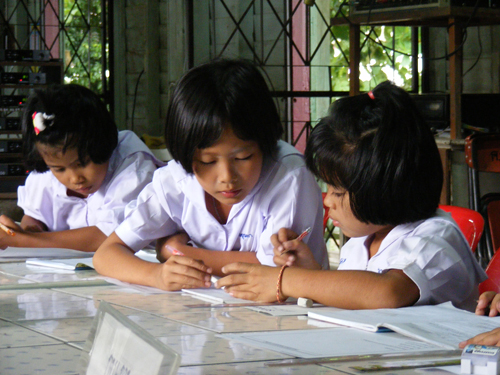
Students in Ban Khung Taphao School in Khung Taphao subdistrict, Mueang Uttaradit, Uttaradit Province, Thailand, 2009. Photographer: Tevaprapas Makklay. WikiCommons.
It is widely acknowledged that access to an education is the most important factor in the success of girls’ lives in the 21st century. Despite the clear benefits, discrimination continues to hold them back from all angles. Access to reliable and safe transportation, adequate supplies, security, family support, and even lack of toilet facilities are all elements that contribute to girls’ non-attendance, despite often being enrolled and wanting to attend.
Family income plays a large role as those with money can purchase uniforms and do not require their daughters to work and contribute financially for their survival. Yet, without the basic tools of literacy and numeracy, girls are unable to compete for jobs or adequately participate in their communities, protect themselves and their families and are more likely to be victimized. The girls from the northern Thai school pictured above are studying and helping each other for the progress of their entire community.
The dolls become a distraction for any evil spirits that might harm the girl. Then for wealthier families, the hina could may be taken to a specific shrine to be blessed. Several shrines in Japan are popular for this festival, typically near water so that the dolls can then be floated out to sea thus ridding the land of the encapsulated negative energies. In this wood block by Sukenobu from 1749, three well dressed girls enjoy their sweet treats as the dolls can be seen set up in the background.
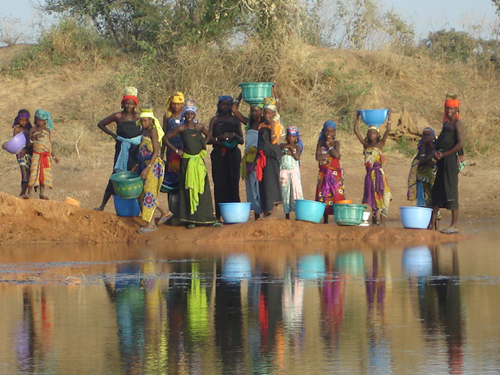
Women and girls collecting water near Waza National Park, Cameroon, February 2007. Photographer: Amy Lee.
Water is the element most closely associated with girls and women as the traditional water collectors, clothes washers, cooks and garbage carriers in most of the world. They are responsible for making sure water is clean, used efficiently and stored properly. However, collecting and maintaining water supplies can take up large parts of every day, and these domestic chores take precedence over other activities, such as going to school. This backbreaking work also exposes girls to violence, chemical pollution and disease.
With firsthand knowledge of environmental changes, girls are vitally important to helping with community conservation and sanitation efforts. The girls and women in Cameroon, pictured above, can walk great distances to fill their water buckets, sometimes several times a day.
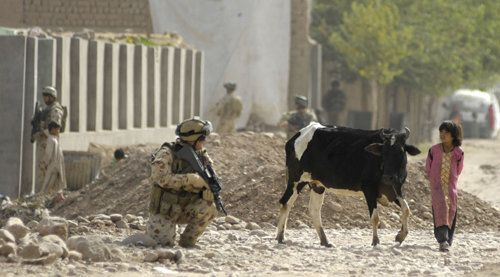
A soldier greets a little girl and her cow during a foot patrol of the town of Tarin Kowt, Uruzgan on an International Security Assistance Force mission, August 18, 2008. Photographer: Petty Officer 1st Class John Collins. WikiCommons.
Children are the first victims of war. They are always traumatized, typically displaced and often orphaned. Armed conflict brings out the base and worst elements of all involved allowing socially unacceptable behaviors in any other context to flourish. There are thousands of conflict refugees in Africa and the Middle East.
However, children fare the worst in transient camps due to overcrowding, illness and violence. For girls, the disruption of daily life, the absence of security, scarcity or inaccessibility of resources can be extremely detrimental. Instances of child rape and survival prostitution, forced labor as soldiers, cooks, looters and mine sweepers as well as disease and malnutrition are all common within war situations.
Most disturbingly, long term exposure to conflict, both domestic and community, becomes their normalized way of life. The above image from south central Afghanistan shows the surreal visual contradiction of youth and death with the heavily armed soldier in close proximity, addressing the girl and her cow. She does not seem frightened by all of the soldiers around her, the constant possibility of violence is likely imprinted on her young personality.
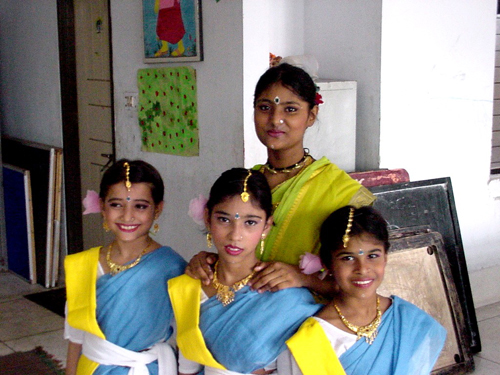
Bangladesh: Rehabilitation Home for Trafficking Victims. Photographer: Troy Beckman, USAID/Bangladesh.
Trafficking humans for slavery is a devastating practice for thousands of years. Today, the proliferation of the sex slavery trade threatens girls from most regions of the globe. Girls are kidnapped, tricked, coerced, and sometimes even sold by their family into situations where escape is virtually impossible. Even if they do manage to escape, their situations may become even more dire with the constant fear of recapture and retribution.
As with all trades, there is clearly a substantial demand for these girls, making this crime difficult to stop. Where there is money to be made, there is always someone willing to procure. However, there is hope. Many international non-governmental organizations (NGOs) are working with specific communities to educate girls about the dangers, thereby helping to reduce their vulnerability.
As well, they provide assistance and income opportunities for families so they are not forced to sell their girls for quick money. Many organizations also are targeting the trade itself and going after the suppliers and those who assist in the trafficking to help save these girls from literally disappearing.
In the image above, these young girls were repatriated back to Bangladesh with the assistance of the Bangladesh National Women Lawyers’ Association (BNWLA). They were given shelter to be rehabilitated and prepared to return to their home communities. They are dressed for traditional Bengali dance, which they learned as part of their healing process.
GirlSpeak, defined:
What is an exhibition? What does a curator do? Are my stories important enough to be in a museum? Are my ideas interesting and good enough?
The Internet has given millions of girls a venue to express their thoughts and opinions about life, the universe- anything that interests them. Girl Museum wants to help provide a structured forum that goes beyond social networks and blogs. Teaching the value of commitment and research are all part of our efforts to raise expectations about process and outcomes. Our platform serves to encourage creativity while giving girls a venue to discuss what is important to them about their own inner lives and the situations they live in.
Thus GirlSpeak is our interactive exhibition series. There will be a range of opportunities to participate, such as themed exhibitions with calls for artwork submission as well as ideas for exhibitions. Additionally, our Youth Curator Series teaches girls how to develop ideas, write proposals, research, write, organize, and promote their own exhibition from start to finish.
There are countless topics for exciting and interesting exhibitions that can provide insight into the lives of girls of today and yesterday. The following are a few examples of upcoming exhibitions open for contributions.

Anne Frank, 12 years old, sitting at her desk at the Montessori school in Amsterdam, 1940. Anne Frank Guide © Anne Frank Stichting.
Who would ever think that so much can go on in the soul of a young girl?’
Having positive role models is essential for a healthy girlhood. All of my girlhood heroines, both real and fictional, were known for their strength, will, intelligence and kindness. However, the most significant person frozen in our collective minds as a girl forever is Anne Frank. The tragedy of her life is how she touched and inspired others through dying. Anne herself stood for qualities all girls should strive for: bold, compassionate, creative, willful and loved being a girl.
Through the words of her diary, Anne’s honesty and curiosity, fears and humor have inspired many to face their petty demons and rise above small mindedness and hatred. With Anne Frank as your friend across time and space, you feel the value of your own self worth and never give up on dreams, always seeing the good and significance in the smallest moments, valuing life above all. This biennial exhibition will explore other girl heroes through images and stories submitted by our audience.
Through necessity and mutual interest, girls have always socialized in their own groups. From the red tent, to the harem, to the court ladies, to the market women, girls have gathered to work, share, compete, and relax.
The prevalence of service and religious organizations that are exclusively for girls, like the Girl Scouts, Rosh Hodesh, the International Order of the Rainbow for Girls, or community groups like the Girls Club or YWCA, there is a strong need for girls to belong, to contribute and to learn from each other. Girls are often the first to organize their families, communities and nations through shared meaning and determination to take action on the issues they value.
The ways in which girls groups have changed the world are numerous and wide-ranging. There are pen pal clubs that promote reaching out for cross-cultural understanding; organizations of girls who raise money so others can have clothes and proper sanitation to go to school, plant trees to rebuild forests and even offer peer counseling.
This exhibition will explore ‘Girl Groups’ throughout history to highlight the amazing work girls continue to do for each other and our planet. This will be comprised of submitted stories and images.
Do you love to draw? Sing? Write stories? Dance? Make cakes? Build circuits? Construct forts? Take care of sick animals?
The lives of most girls have changed dramatically during the past 150 years. Every succeeding generation of women have had different opportunities open to them. When we are young, there are endless possibilities for future careers and life paths.
The activities we enjoy doing most in our girlhood often indicate our most innate talents. Depending on each situation, our talents are either nurtured and encouraged, or put aside for either arbitrary or sometimes important reasons.
Our ‘Talent’ project is a discussion with girls about their talents and passions, with the help of women who have pursued these talents into adulthood and found success with them. While life may seem to be all about compromises, living your dreams is worthwhile, even if they change over time. This exhibition is based on artwork, photographs, audio and video submitted by girls and women from around the world.
In the 1950s, American children were heavily influenced by new entertainment technology- the television- and the popular Wild West theme of many of the earliest programs. The enduring image of the cowboy with pointed boots, wide-brimmed hat and revolver are synonymous with the pioneer spirit of America.
While women in early television were mainly decorative, Dale Evans and Annie Oakley, the token cowgirls, gave girls a role model within this important cultural context. Cowgirls were brave- they rode horses and carried guns. Playing at being a cowgirl gave real girls the excuse to get dirty, to stand up for themselves and learn to swing a lasso along side their brothers.
This little cowgirl in full regalia maintains an angelic face while aiming her cap pistol directly at the photographer. Our ‘Play’ exhibition will explore historical and contemporary forms and aspects of play, including games, songs, stories, costumes, interviews and video.
Education Guide
To explore this exhibition in more depth, download our Education Guide. This guide is prepared for use at home or in the classroom, aligned to US and UK educational standards, and features fun activities to help you explore our museum and collaborate with us!
Credits
Curator: Ashley E. Remer
Pictorial Researcher: Faith Chisholm
Fact Researcher: Matthew D. Remer
Thanks to Marcia Brown, Anna Lee, Sioux Remer, Verna Tobin, Sara Morsey and for their support in producing our first exhibition.


